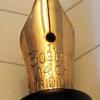Search the Community
Showing results for tags 'surface tension'.
-

Pens That Change From Bone Dry To Very Wet
TheDutchGuy posted a topic in Fountain & Dip Pens - First Stop
In this discussion, I noted that a lot of my newly bought pens started out bone dry but became wet (or even very very wet) later on. Initial flushing and cleaning to clear out oils and residues didn't help. Using very wet inks didn't help, or only a little bit. I think this phenomenon may be relevant because quite a few people complain of certain pens being (too) dry. Kaweco is a brand that is often mentioned in this context and sure enough my two Kawecos were initially very dry. So was my Visconti van Gogh, that one was unusable. Over time, these pens very gradually became wet and the Visconti became very wet. I'm now sort of moving towards dryer inks with these pens! The conclusion is that (for example) Kaweco pens are not dry pens, but that many of them start their life as a dry pen. Why? Many people start tinkering with nibs to make new pens wetter. Is this needed? I think (emphasis on: think) the answer lies in materials science. The nib is new and has not been exposed to ink yet. The feed is new. The converter is new. Flushing and cleaning may help a bit, but it didn't help me much with these pens. There's a lot of surface area in a feed. My hypothesis is, that over time, with use, the surface tension characteristics of the converter, the feed and the nib change. This then gradually leads to a wetter pen. This hypothesis is supported somewhat by my observation in multiple pens that a small drop of glycerine speeds up this process; immediately the pen becomes wetter, and after one or two fills with glycerine-enriched ink the pen it stays wetter (search FPN for glycerine; much has been said about it; it's completely different stuff than photoflow). My personal view is, that wetness can only be objectively determined in a well-used pen. Saying that a new pen is dry is like saying that a freshly picked green banana is hard. The banana takes time to ripen. A pen takes a lot of use to show its true character. It might be different with top-quality pens like an M1000 or a 149 or something similar. I didn't notice it with my new Sailor pens, for example. But with entry-level or intermediate-level pens, I've noticed this too many times for it to be a coincidence. In reverse, a new pen that is very very wet might become too wet later on. Something to watch out for. My approach now is: if I like a new pen in every aspect except dryness, I thoroughly flush it, clean it and then add a little bit of glycerine to the first two fills. Then I do a fill without glycerine. This seems to do the trick. Anyway, just my 2 cts. (Obviously we might criticize the manufacturer for such temporary dryness, but there's probably not much point in doing so.)- 11 replies
-
- wetness
- capillary force
-
(and 1 more)
Tagged with:
-

Adding Agitator To Parker Piston Converter?
3nding posted a topic in Fountain & Dip Pens - First Stop
Hi everyone, What are your suggestions/ideas/tricks for adding an agitator to a Parker piston converter? From what I can't tell, they can't be taken apart without breaking them although I might be wrong about that. Have you found anything that works well and doesn't come out too easily? Thank you all very much in advance! 3nding- 20 replies
-
- agitator
- parker piston converter
- (and 8 more)
-
I've had a Waterman Kultur for some time, but I've never been happy about its performance. It dries too easily, and writing isn't either smooth or continuous. I've realised that the ink seems to get sort of clotted in the upper (as I write) part of the piston converter. Since I store the pen with the nib upwards, it seems that the ink falls down because of the law of gravity, but then the law of gravity is not enough to make it fall again when it put it with the nib downwards, so the pen writes until the ink that floods the feed runs out. I give a few taps to the pen, the ink falls and I can carry on writing... Until I store the pen again, nib upwards, and next time the ink is again at the top of the converter. I've read somewhere that this is related to the ink's surface tension. I've tried to change the ink I'm using with this pen, which is usually Montblanc Oyster Grey, and use Waterman Serenity Blue instead, but the result's been the same. I read that one option is to put one of the small balls that can be found inside cartridges inside the converter. Even though they say that converters can be disassembled by unscrewing the metallic ring, I haven't been able to unscrew mine. Either I lack the skill, or the strength. However, I saw that the ball of the cartridges I have at home (Faber-Castell, the only brand I can find near my home) have a very small ball. I thought that perhaps, with a little push, I'd be able to put it inside the converter through its hole. But it didn't even need the push. The ball's so small that it went easily in. So my question is: if I've got this ball whose diameter is smaller than that of the converter rim, would it be dangerous to fill the converter and see whether the surface tension problem is solved? Can the ball come out of the converter and block the feed of the pen, or something like that? Or is it safe to have a go?
- 68 replies
-
- surface tension
- converter
-
(and 1 more)
Tagged with:

